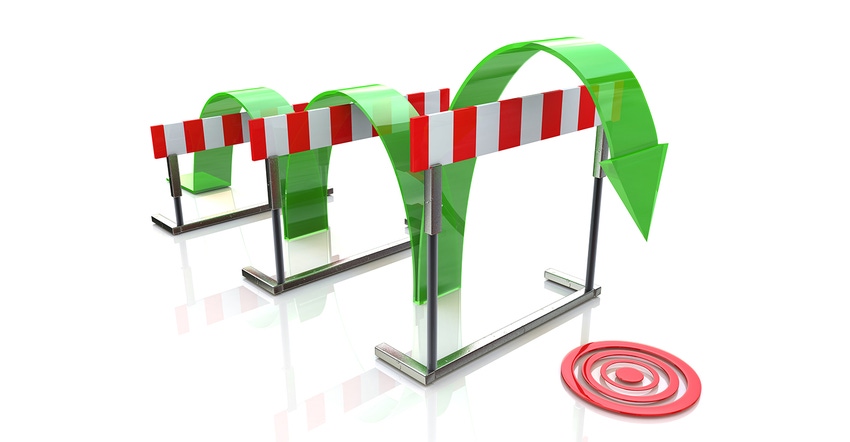We need to build a series of biosecurity protocols that you can think of as a series of hurdles, each with a different purpose and efficacy.

The race to keep African swine fever out of the U.S. swine herd, is not a race that the industry, nor the entire U.S. economy, can afford to lose. Much has been written and said about the damage that ASF would do to the U.S. economy, literally shutting down export markets.
So, it is best that the entire swine industry gets limbered up for the race to keep ASF at bay. Early in May, the National Pork Board issued a press release on new research revising holding times of feed and feed ingredients to lessen the risk of ASF getting into the U.S. herd. The NPB is just one group that had a hand in this holding time revision, joining the National Pork Producers Council, the Swine Health Information Center and the American Association of Swine Veterinarians. SHIC and the Institute for Feed Education and Research, the public charity of the American Feed Industry Association, helped fund this research resulting in this updated information.
Paul Sundberg, SHIC executive director, says it’s going to take a concerted effort to help the industry win the race in keeping ASF far away from our pigs, adding that there is no silver bullet. “There is no one thing, that if you’re going to do this, you’re going to be completely safe,” he says, “so what we need to do is build a series of biosecurity protocols that you can think of them as a series of hurdles. And each hurdle might be a little different in height, and each might be a little different in efficacy, but when you put them all in a line, the first hurdle might take 75% of the risk away. The second hurdle might take another 10% of the risk away. The third hurdle might take another 40% of the risk away. Eventually what you do is you put enough hurdles in between the outside and the pig that you’re getting the risk down to zero or as close to zero as you can.”
Sundberg says the current issue with feed and feedstuffs is that there is no series of hurdles in place, such as holding time and mitigants.
“Let’s just say that if we import any of these feed ingredients and they have African swine fever in them and we don’t apply a holding time or an additive to the feed or any other mitigation that is just about a direct pipeline between that outside of the country and our pigs because we don’t have any of those biosecurity hurdles in there,” he says.
Sundberg acknowledged farms do have biosecurity measures in place to keep pigs healthy. “On a farm, you do shower in. That’s one thing. You change into farm-specific coveralls. That’s another thing. You don’t let people enter onto the farm through some back door. That’s a third thing,” he says. “All of those things are hurdles designed to keep pathogens away from our pigs. We’re trying to develop those hurdles for feed because otherwise if we don’t, we very well may have a back door wide open that those viruses can walk through and have direct contact with our pigs. So, we’re putting into place feed-specific hurdles or feed-specific mitigations to have biosecure feed supplies. And one of those things, one of those mitigations, one of those hurdles is a holding time.”
As in a hurdle race on the track, the runner does not jump over a single hurdle, he/she must successfully clear each of the hurdles to finish the race.
If Sundberg could have his wish list, No. 1 would be to source feed ingredients from an area that has low or no risk for foreign animal diseases, specifically ASF. “If I’m a U.S. producer, if I source it within the U.S., I know I’m not at risk for African swine fever. Period.
“Second thing, if I can’t do that, then I want it sourced from an area and let’s say it’s China or anywhere else. I want to know that it was clean when it was manufactured and it’s clean when I got it. And that is process control. That’s hazard analysis and risk control, and it’s blockchain.”
Third on his feed safety wish list is either adding a feed ingredient or a holding time. “If I can’t source it from a (ASF) free area or I can’t source it from a biosecure facility and know it’s going to be biosecure through the whole thing, then I want to do either a holding time on it or add a feed mitigant to it, add a feed additive that will help decrease it, or both.”
SHIC is just one of the many entities (National Pork Producers Council, National Pork Board, American Association of Swine Veterinarians) that have resources available for producers and feed suppliers to help win the race against ASF and any FAD. View the Feed Ingredient Safety decision tree on the SHIC website.
Just as there isn’t a lone hurdle in a race, there rarely is a lone runner. There is a full field of participants, and we all need to be as best prepared as possible so that we don’t stumble in this very important race for our industry.
About the Author(s)
You May Also Like



